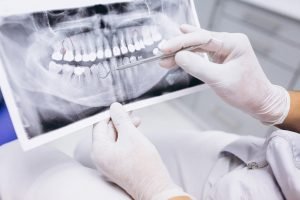Dental X-rays
 Dental X-rays, also called radiographs, are digital images of your teeth that dentists use to evaluate your dental and overall oral health.
Dental X-rays, also called radiographs, are digital images of your teeth that dentists use to evaluate your dental and overall oral health.
X-rays use low levels of radiation to take images inside your teeth and gums.
This helps your dentist detect oral problems like tooth decay and impacted teeth growth.
Dental X-rays may seem very complicated, but they’re a common treatment that is just as important as teeth cleaning.
The aspects that influence how often you undergo dental X-rays may include:
- your age
- current oral health condition
- symptoms of an oral disease
- a history of cavities or gum disease
Children may need to undergo dental X-rays more often than adults because dentists need to keep track of their permanent teeth.
Dental X-rays can help the dentist decide if baby teeth need to be extracted to prevent issues.
Types of Dental X-rays
There are two types of dental X-rays performed in the dentist’s office – intraoral and extraoral X-rays.
Intraoral X-rays produce digital images of the teeth, bite, and gums from the inside of the mouth.
Bite-Wing X-rays require biting down on a piece of paper so the dentist can see how well the teeth relate to each other. This is often performed to check for cavities between teeth.
Occlusal X-rays are done with the jaw closed to see how the upper and bottom teeth fit each other.
They can also spot irregularities in the floor of the mouth or palate. This technique captures images of all the teeth in just one shot.
Panoramic X-rays are used to examine the wisdom teeth, plan for implanted dental devices, or inspect jaw problems.
Periapical X-rays focus on two complete teeth from root to crown.
Extraoral X-rays may be used when the dentist suspects there might be problems in areas outside the teeth and gums, like the jaw.
Preparation for Dental X-rays
Dental X-rays require no specific preparations. You just need to brush your teeth before coming to your X-ray appointment.
This creates a cleaner environment for those working inside your mouth. X-rays are usually performed before cleanings.
At Bondi Dental, you’ll sit in a chair with an apron across your chest. The X-ray machine is placed beside your head to take and record images of your teeth and entire mouth.
A dental hygienist will guide you through every step of the procedure.
Stay still while the images are being taken and recorded. The spacers will be shifted and adjusted in your mouth to take the images properly.
After Dental X-rays
Your Bondi dentist will examine your X-rays and check for abnormalities. If your dentist spots any problems, such as cavities or gum issues, they’ll discuss your treatment options.
Dental X-rays at Bondi Dental
Dental X-rays performed at Bondi Dental are safe and helpful in the diagnosis of potential problems. If you want to schedule an X-ray appointment with your Bondi dentist, visit us today!
Call us on (02) 9365 7187 or request your appointment online today!
We are located at 134 Curlewis St in Bondi Beach.

